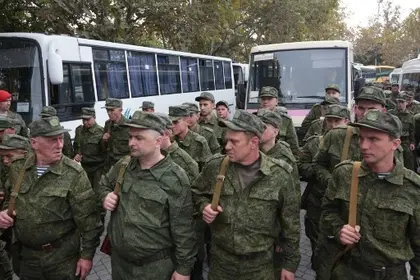A group of women wearing winter coats gathered outside a municipal building in the northwestern Russian city of Cherepovets last month.
In a video published on the Russian social-media platform VK, one woman reads aloud an appeal to President Vladimir Putin, complaining that their husbands had been issued "illegal orders."
JOIN US ON TELEGRAM
Follow our coverage of the war on the @Kyivpost_official.
Others stand holding signs that read: "We request demobilization" and "Bring our men home."
"Help our guys, please," the women chant in unison.
The women's appeal was prompted by the plight of their husbands, deployed to fight in Ukraine with the 347th Motorized Infantry Regiment, a unit in which Dmitry Yashnikov served beginning during Russia's mobilization in September 2022 until he was badly wounded about three months ago.
"Nobody is eager to fight. Everyone wants to go home," the 41-year-old said in an interview with RFE/RL's North.Realities.
"We've been stuck in this mess for a year now. Everyone is tired and wants to return to peaceful life."The grumblings, while not widespread, are already causing political headaches, a reflection of a problematic circle that Russian leaders are struggling to square: Russian's military has a manpower problem in Ukraine.
Putin's mobilization order 14 months ago sent tens of thousands of men to the front lines to try and reverse Russia's struggling invasion. But the bloodletting continues, and the longer it goes on, the more men are needed. And the more men that are needed, the more likely a second mobilization becomes.

Moldova Residents Caught in the Middle of Gas Fight
Which the Kremlin wants to avoid four months before a presidential election that Putin is expected to run in again."The Kremlin is still trying to 'buy blood' instead of mobilization," said Pavel Luzin, an expert on the Russian military and a scholar at the Fletcher School of Law and Diplomacy at Tufts University. "In this way, the Kremlin is almost at the fork: it crucially needs a cease-fire, but it also tries to be prepared for the worst scenario when there will be massive mobilization together with the economic mobilization," he said.
"It's clear from their actions that the Kremlin would prefer to offer large sums of money for volunteers, raid the Russian prison system, restaurants, or other gatherings for manpower, rather than [do] another round of mobilization," said Dara Massicot, who researches the Russian military at the Carnegie Endowment for International Peace.
The bloodletting for both Russia and Ukraine is unrelenting. Russian casualties -- killed and wounded -- since February 2022 are estimated at around 302,000, according to British officials. Ukrainian casualties have been pegged at around 180,000 as of this summer, according to unnamed U.S. officials.
So how do you get more Russian men into the system without another mobilization?
"I'm pretty sure [Putin] knows the situation quite well, and it's alarming when it comes to manpower in Ukraine," said Pentti Forsstrom, a retired Finnish Army lieutenant colonel and professor at the National Defense University in Helsinki.
Conscription Breakdown
In September 2022, amid indications that Ukraine was inflicting greater losses than Russian commanders had foreseen, the Kremlin took the drastic step of ordering mobilization, calling up around 300,000 military reservists and other eligible men, known informally as "mobiki."Overall, the mobilization process was shambolic. For wide swaths of Russian society, it was also shocking.
Since then, Russian recruiters and registration officers have been tinkering with the antiquated systems set up to handle the country's conscription and enlistment system.Under conscription, all men between 18 and 27 are obliged to serve one year in the armed forces, resulting in hundreds of thousands of men being absorbed during each of the two biannual conscription periods.
It's a decades-old system known for its inefficiency and corruption.Recruiters have sought to modernize computer systems to track eligible men, and lawmakers moved to set up a digital database that makes it easier to serve draft papers, both for conscripts and for those eligible for mobilization.
The system relies on an existing national government web portal called Gosuslugi, which Russians use to do things such as pay taxes or apply for pension or disability benefits.Under a law passed earlier this year, a person can be penalized for ignoring draft notices, regardless of whether they use Gosuslugi. Punishments include being banned from leaving the country or being prohibited from driving, getting a home, or registering a small business.
Recruitment By Other Means
Under current law, however, conscripts are not allowed to serve outside of Russia's borders, nor are they allowed to serve in combat.
Still, military planners have tried to come up with other ways to tap that pool of trained soldiers. That includes recruiters pressuring or coercing men concluding their service year into immediately signing volunteer contracts to enlist.
Military planners have dangled economic incentives to great effect. Mobilized recruits and volunteers are supposed to receive the same pay and benefits as professional armed services personnel who have signed contracts. The monthly salary is a minimum 195,000 rubles ($2,115) -- nearly three times the average monthly wage. In Russia's poorer regions, that's an eye-catching sum.
The Kremlin also provides substantial survivor benefits for relatives of soldiers killed in action: more than $140,000, a sum that dwarfs the lifetime earnings for the average Russian man. Another estimate put the total amount of payments, subsidies, and other benefits provided to a soldier's kin at more than $170,000.
"Recall that the Russian government has made being killed in the war a windfall for a soldier's family," Aleksandr Golts, a veteran Russian military reporter now based in Sweden, wrote in a recent analysis.
t's unclear exactly how many men have voluntarily signed contracts.Earlier this month, Dmitry Medvedev, the former president who is now the deputy chief of the Russian Security Council, said 410,000 men had signed up since January, a number that experts say likely includes prison inmates and migrant workers from other countries.
Military planners have also utilized stop-loss clauses -- the involuntary extension of soldiers' contracts -- which went into effect for an unknown number of volunteers and mobiki last September.
At a meeting with reporters earlier this month, Putin echoed what some lawmakers had said previously: mobiki would be obliged to serve until the end of the "special military operation," the Kremlin euphemism for the war.
Wagner 2.0
Officials have also employed other tools.
Last year, the Defense Ministry looked to the private mercenary company Wagner, whose well-paid fighters were seen as more competent and better-trained, to lead the charge in several places, including the Donetsk region city of Bakhmut.In addition to competent fighters, Wagner's founder, the late Yevgeny Prigozhin, was also given the green light to recruit thousands of prison inmates. Those inmate units were widely seen as cannon fodder, poorly trained and frequently deployed in infantry waves to overwhelm Ukrainian positions.
In the wake of Prigozhin's death in August, Wagner was more or less absorbed by the Defense Ministry and other paramilitary entities, like the National Guard or the Chechen militia known as Akhmat.
Military planners have recruited soldiers through other informal volunteer units, under different systems: one collectively known by the Russian acronym BARS and the other through an entity called Redut.
These units, many of which are organized through obscure Defense Ministry entities, are also ostensibly private mercenary groups like Wagner used to be, but smaller, more disparate, and with various funding sources.
The Way Home
Fueling the ire of soldiers' wives and mothers is another tool that military commanders have relied on: not rotating out exhausted units with fresher ones or allowing extended leaves of absence.
In early September, a Telegram channel with around 400 subscribers called The Way Home, published instructions for people to write to elected politicians in order to ask for the rotation of their sons or husbands.
The channel has since exploded in popularity. On November 12, it published a manifesto in which it called for "complete demobilization, political stability, and a decent life for every citizen of Russia."It's unclear who is behind the channel; organizers could not be reached for comment.
Since then, protests and public appeals similar to what happened in Cherepovets have started popping up.In Moscow earlier this month, the authorities rejected an application for a public demonstration. In response, dozens of women -- some holding signs reading "It's time for the mobilized to come home" -- staged a spontaneous rally alongside an authorized demonstration hosted by the Communist Party.
Police cordoned the group off after about five minutes.In the Siberian city of Krasnoyarsk, the authorities rejected an application by another group to hold a demonstration on November 11, citing concerns over the COVID-19 virus. St. Petersburg officials blocked a demonstration requested for November 26.
The outbursts of dissent hinge mainly on the question of bringing soldiers back from Ukraine. Few, if any, express outright opposition to the war.One woman identified only as Nina posted a video on The Way Home in which she said she supported the war, framing it using the same false trope that the Kremlin has used to justify it: that Russia is fighting "fascism."
"Personally, I'm not opposed to the special military operation. I don't support the idea of making peace with fascism," she said. "But it's completely unfair that they have been carrying out the duties of professional military personnel for the 14th month, indefinitely and permanently, just like slaves."
It's clear the authorities are moving to keep the dissent from morphing into something bigger.In Krasnoyarsk and another Siberian city, Kemerovo, police officials visited some of the protest organizers ahead of rallies, threatening possible punishment if they went through with them.In Novosibirsk, officials held a closed-door meeting with soldiers' wives, reportedly warning them not to hold public protests. State media outlets were allowed to attend the meeting; independent journalists were not."
The goal is to make sure these families feel intimidated, watched, and alone," Massicot said. "They don't want them to show regional or national solidarity or even form those bonds.""The Russian authorities will allow some very carefully managed pressure releases like what you see in Novosibirsk," she added. "They do not want wives or mothers banding together across regions or taking inspiration from each other. They want to keep them siloed.
"Mobilization 2.0?
There's been virtually no public discussion about the prospect of a new mobilization; Russian casualty figures are never discussed by state media. Still, the possibility has seeped into some corners of society.А survey by the polling company Russian Field showed 58 percent of respondents opposed the idea, while just 32 percent were in favor. The poll surveyed 1,611 Russians by telephone during the last week of October.
For the moment, Russia's manpower problems mean its forces won't be able to make substantial battlefield movements, stuck instead with what military experts call "positional warfare."
"They don't have the manpower to conduct any sort of major offensive operations. Only small things, a battalion or a regiment or at the brigade level, just to keep the contact with the Ukrainians," Forsstrom, the Finnish analyst, said.
Given the unpopularity of a new mobilization, the Kremlin is expected to avoid it, or any mention of it, in the run-up to the March election. After that, however, the chances for a second mobilization increase markedly.
"The second wave of mobilization will come," Forsstrom predicted. "It will come right after the presidential election, before the summer. They could have at least a few weeks of training before going to the front, and the summer campaign begins, when [mud season] ends, when the roads are drivable. Then it will happen."
You can read the original here.
Reprinted from the Radio Free Europe/Radio Liberty with the editorial board's permission.
You can also highlight the text and press Ctrl + Enter











